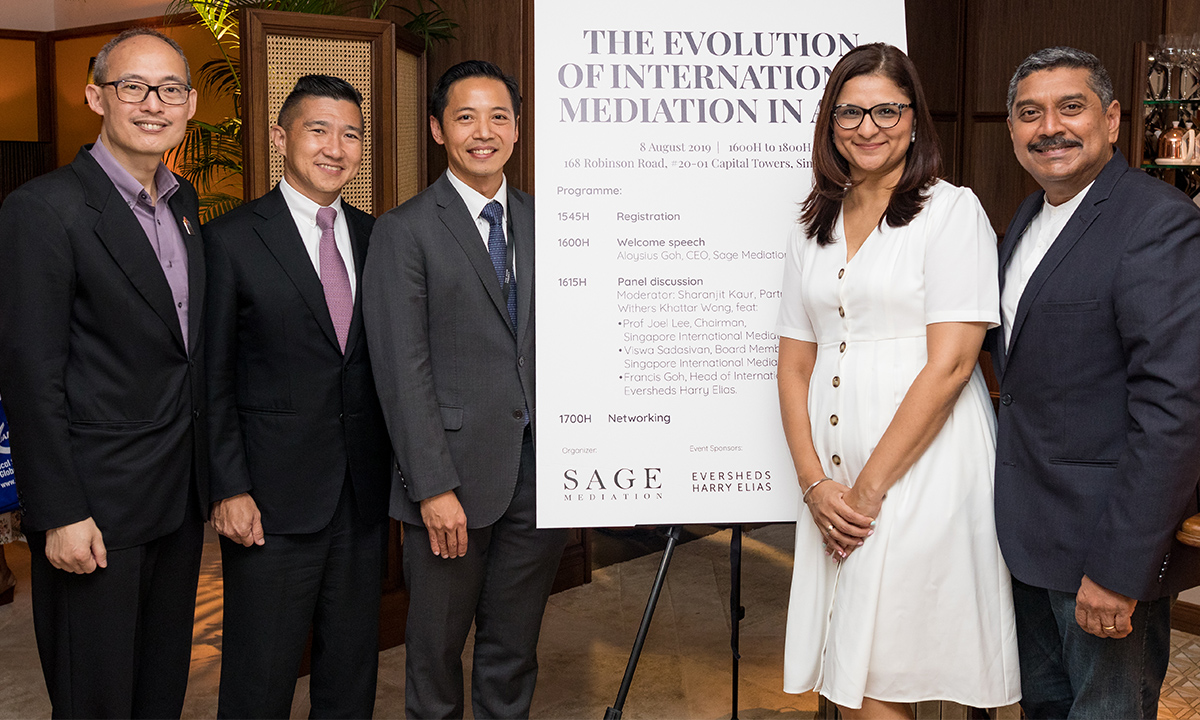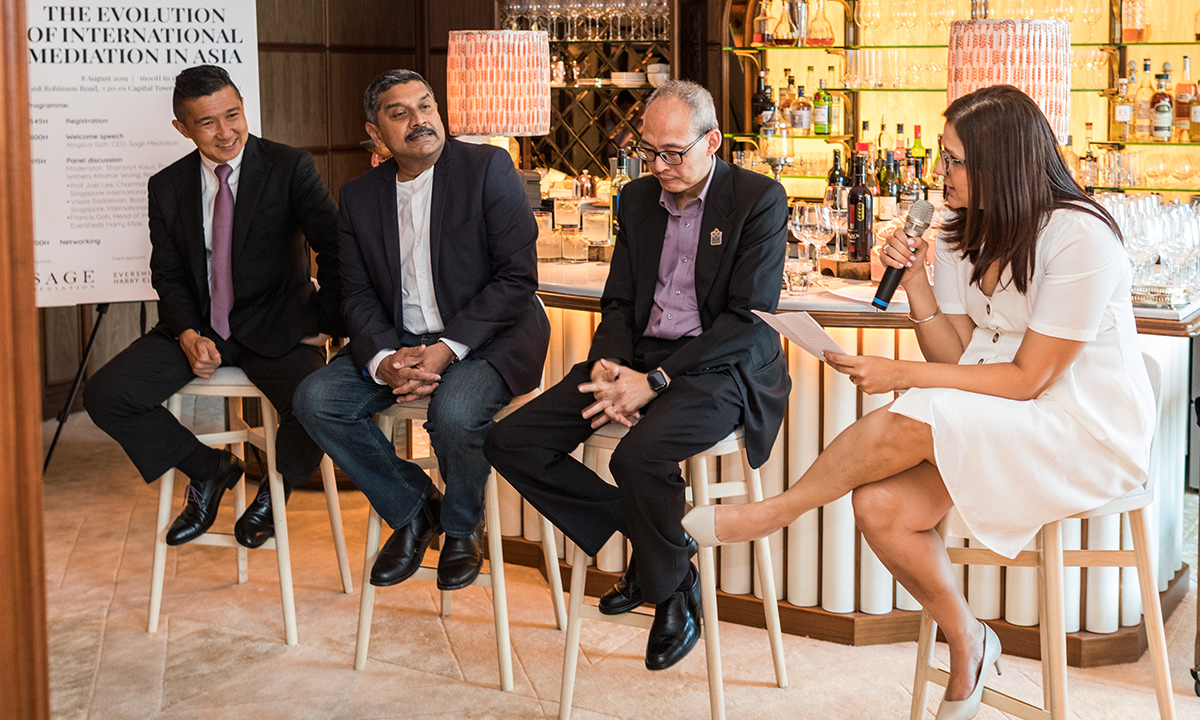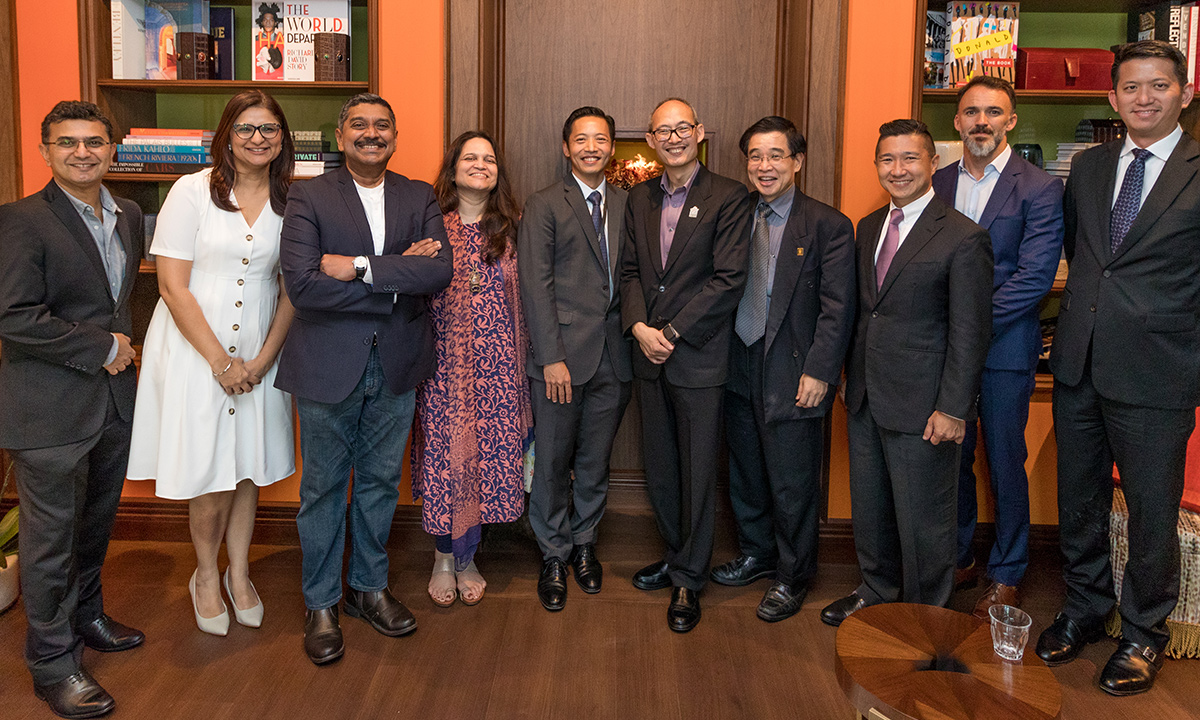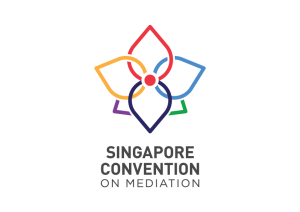
Sage’s first corporate event featured four eminent Sage Advisors who spoke on how international mediation was likely to evolve in Asia post the Singapore Convention on Mediation.
The 62 guests from Singapore, Japan, India, and the USA, were indebted to Ms Sharanjit Kaur, Partner at Withers KhattarWong LLP, whose skilful moderation enabled the panellists to proceed on a deep exploration of a wide spectrum of issues.

The Panellists: Francis Goh, Viswa Sadasivan, Joel Lee, and Sharanjit Kaur.
Setting a High Bar In Defining Universal Mediation Norms
Prof Joel Lee, Chairman of the Singapore International Mediation Institute (SIMI), highlighted that mediation standards will evolve to take in the diversity of cultures and gender. The Convention added urgency to the work of practitioners seeking to define the universal norms for mediation.
Joel observed that as mediation became popularised, there would be a temptation to dilute the standards of mediation practice. To prevent this, those defining the standards should set the bar high even if this led to disagreement amongst them. Working through the disagreements was part and parcel of raising the quality of mediation practice. Not being able to achieve perfection must not keep us from aiming for better.
Joel’s comments resonate with my own encouragement for those seeking to be international mediators to develop “cultural fluency”. As mediators practice beyond the comfort of culturally familiar communities they would need to be deeply mindful of their own cultural biases and be able to align their practice to the contexts and needs of the disputants. The best international mediators would be recognised by the depth of their preparation and their ability to adapt their approach to build empathy and rapport with parties from different cultures.
Users Shaping the Mediation Narrative
Mr Viswa Sadasivan, CEO of Strategic Moves, and Board Member of the Singapore International Mediation Centre (SIMC), drew on his experiences in leadership and crisis management consulting with many government leaders and C-suite executives of Fortune 500 companies, and suggested that for mediation to gain acceptance and for its practice to grow in quality, there needed to be a deliberate shift in how it was perceived and described by political, legal, and business leaders.
One example was to stop labelling mediation as a “soft” option compared to litigation and arbitration and to respect mediation skills training as a subject which was as intellectually rigorous as any other. Part of the process was for the legal fraternity to relook at how it ranked lawyers’ competency. Viswa suggested that as “counsel”, lawyers should be measured not by how many cases they won in court, but how many problems they solved for their client and how well they took care of their clients’ interests.
For Viswa, the Convention was an opportunity for leaders to move the communities they serve in away from adversarial dispute resolution processes and to encourage collaboration. One way to achieve this was to include the voice of the business community when setting mediation standards. To this end, Viswa felt that more business leaders should be equipped to serve as mediators for their peers.
Like Viswa, I believe that the mediation narrative must be co-written by a wider spectrum of stakeholders. Quite apart from the business community, one particular group that has always fascinated me has been the youth. Youth perspectives have never ceased to energise me because of their truthfulness and the authenticity they demand of me in return.
One of the motivators in establishing Sage has therefore been to give the youth that platform to articulate their visions for mediation practice. A big shout out to Victoria, Ahvinesh, Hui Lyi, and Dikaios from the National University of Singapore Law School, and to Tanushri from the University of Delhi and Ibrahim from the BPP University in London (Member of Lincoln’s Inn) for making time to attend the event and helping out.

Tanushri and Ibrahim, with Viswa Sadasivan and Francis Goh
Hybrid Dispute Resolution Process Design
Linked to evolving mediation standards, ADR practitioners would need to deal with the issue of process-design. Mr Francis Goh, Head of International Arbitration at Eversheds Harry Elias LLP pointed out that ADR processes were already modernising with the introduction of hybrid processes such as the arbitration-mediation-arbitration protocol. The aim was to reduce dispute resolution costs, increase predictability of the outcome, and to offer parties closure faster.
Harking back to the point made by Viswa, Francis observed that with the modernisation of dispute resolution processes, the role of counsel would necessarily also be redefined. The renewed focus on client interest and needs was a positive as it provided an important counter-weight to the pressures on lawyers to put their business ahead of service in many legal firms.
Looking back to when he first became accredited as a mediator, Francis shared that peers had queried why he would choose a path that would lead to a loss of fees. However, in the 20 years since his accreditation, this had not been his experience. The opposite was true. Clients trusted him to provide the right advice on when to fight and when to take a step back, and this led to retention of those clients who typically would have more than one legal need.
Quick Closing Thoughts
About 5 years back, I had the good fortune to chat with Dr William Ury, co-author of the seminal book Getting to Yes, and discuss the establishment of the Singapore International Mediation Centre (SIMC). He shared that Singapore with its “intellectual infrastructure” was the perfect place for the first centre of its kind to be established. I didn’t get a chance to clarify that metaphor with him during our conversation and the comment intrigued me even as I knew he meant it to be compliment.
What is this “intellectual infrastructure” that so distinguished us?
Singapore’s demographic is extremely small which means that the talent pool is proportionately minute compared to the USA, Europe, China, India, Korea, and Japan. It’s not that we don’t have talent and on contrary, I’ve met countless hyper-talented Singaporeans. My question was what made Singaporean “talent” unique and relevant to the world.
The high quality panel discussion reinforced my view that the uniqueness of Singapore talent lay in 3 characteristics: (1) being always outward-looking and humble enough to recognise that there’s more to learn and do, (2) being deeply motivated to behave honourably and to preserve a social order that protected the rights of the minority, and (3) having a keen regard for the long term impact of our ideas such that the legacy created by our efforts last beyond our lifetimes.
As a Singaporean, having the Convention on Mediation named after Singapore is a great honour. I believe many of my fellow mediators in Singapore share my sense of the responsibility we now carry to ensure we do not let down the global mediation practice.
The quality of the discussion at Sage’s first event and the questions asked by the audience give me great hope and confidence!

Sage Mediation Advisors
Yes, I don’t deny, one criteria for the choice of Sage Advisors was looks!
Note: All credit for the photos belong to Mr Dikaios Pang.



